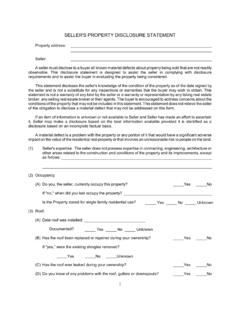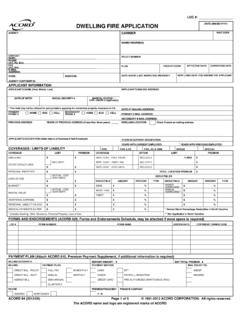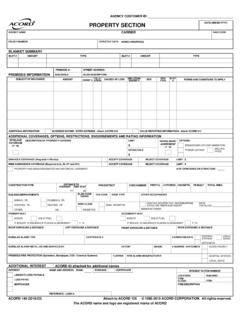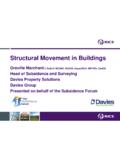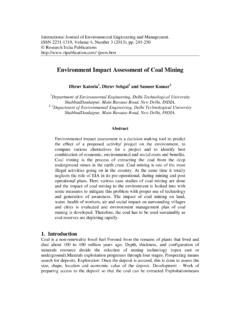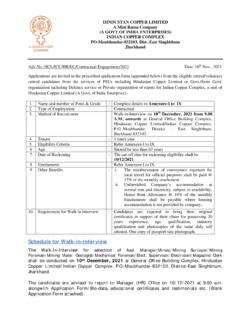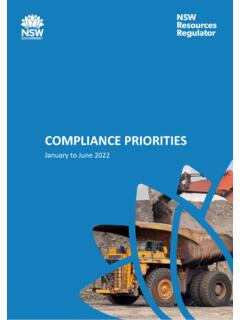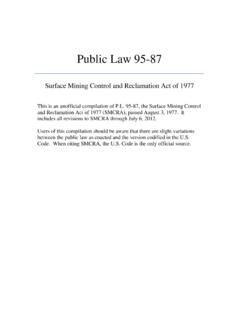Transcription of LECTURE NOTE ON SURVEYING AND LEVELLING - PKACE
1 LECTURE NOTE ON SURVEYING AND LEVELLING4TH SEMESTER CIVIL ENGINEERINGPREPARED BY SASWAT SUMAN SHARMADEPARTMENT OF CIVIL ENGINEEERINGD isclaimerThis document does not claim any originality and cannot be used as a substitute for prescribed textbooks. The information presented here is merely a collection by the author for their respective teaching assignments. We would like to acknowledge various sources like freely available materials from internet from which the LECTURE note was prepared. The ownership of the information lies with the respective authors or institutions. Further, this document is not intended to be used for commercial purpose and the author is not accountable for any issues, legal or otherwise, arising out of use of this document.
2 The author makes no representations or warranties with respect to the accuracy or completeness of the contents of this document and specifically disclaim any implied warranties of merchantability or fitness for a particular 1 Introduction: SURVEYING is defined as taking a general view of, by observation and measurement determining the boundaries, size, position, quantity, condition, value etc. of land, estates, building, farms mines etc. and finally presenting the survey data in a suitable form . This covers the work of the valuation surveyor, the quantity surveyor, the building surveyor, the mining surveyor and so forth, as well as the land surveyor. Another school of thought define SURVEYING as the act of making measurement of the relative position of natural and manmade features on earth s surface and the presentation of this information either graphically or process of SURVEYING is therefore in three stages namely:(i)Taking a general viewThis part of the definition is important as it indicates the need to obtain an overall picture of what is required before any type of survey work is undertaken.
3 In land SURVEYING , this is achieved during the reconnaissance study.(ii)Observation and MeasurementThis part of the definition denotes the next stage of any survey, which in land SURVEYING constitutes the measurement to determine the relative position and sizes of natural and artificial features on the land.(iii)Presentation of Data:The data collected in any survey must be presented in a form which allows the information to be clearly interpreted and understood by others. This presentation may take the form of written report, bills of quantities, datasheets, drawings and in land SURVEYING maps and plan showing the features on the of SurveyingOn the basis of whether the curvature of the earth is taken into account or not, SURVEYING can be divided into two main categories:Plane SURVEYING : is the type of SURVEYING where the mean surface of the earth is considered as a plane.
4 All angles are considered to be plane angles. For small areas less than 250 km2 plane SURVEYING can safely be used. For most engineering projects such as canal, railway, highway, building, pipeline, etc constructions, this type of SURVEYING is used. It is worth noting that the difference between an arc distance of km and the subtended chord lying in the earth s surface is 7mm. Also the sum of the angles of a plane triangle and the sum of the angles in a spherical triangle differ by 1 second for a triangle on the earth s surface having an area of 196 SURVEYING : is that branch of SURVEYING , which takes into account the true shape of the earth (spheroid).Classification of surveyingIntroductionFor easy understanding of SURVEYING and the various components of the subject, we need a deep understanding of the various ways of classifying enable the students have understanding of the various ways of classifying SURVEYING Classification Of SurveyingSurveying is classified based on various criteria including the instruments used, purpose,the area surveyed and the method on the Basis of Instruments on the instrument used; surveys can be classified into;i) Chain tape surveysii) Compass surveysiii) Plane table surveysiv) Theodolite surveysClassification based on the surface and the area surveyed i) Land surveyLand surveys are done for objects on the surface of the earth.
5 It can be subdivided into:(a) Topographic survey: This is for depicting the (hills, valleys, mountains, rivers, etc) and manmade features (roads, houses, settlements ) on the surface of the earth.(b) Cadastral survey is used to determining property boundaries including those of fields, houses, plots of land, etc.(c) Engineering survey is used to acquire the required data for the planning, design and Execution of engineering projects like roads, bridges, canals, dams, railways, buildings, etc.(d) City surveys: The surveys involving the construction and development of towns including roads, drainage, water supply, sewage street network, etc, are generally referred to as city survey.(2) Marine or Hydrographic Survey: Those are surveys of large water bodies for navigation, tidal monitoring, the construction of harbours etc.
6 (3) Astronomical Survey:Astronomical survey uses the observations of the heavenly bodies (sun, moon, stars etc) to fix the absolute locations of places on the surface of the earth. LECTURE 2 CLASSIFICATION ON THE BASIS OF PURPOSEi) Engineering surveyii) Control Survey:Control survey uses geodetic methods to establish widely spaced vertical and horizontalcontrol ) Geological SurveyGeological survey is used to determine the structure and arrangement of rock , it enables to know the composition of the ) Military or Defence Survey is carried out to map places of military and strategic importanceiv) Archeological survey is carried out to discover and map ancient/relies of antiquity.
7 Classification Based On Instrument Usedi. Chain/Tape Survey: This is the simple method of taking the linear measurement using a chain or tape with no angular measurements Compass Survey: Here horizontal angular measurements are made using magnetic compass with the linear measurements made using the chain or Plane table survey: This is a quick survey carried out in the field with the measurements and drawings made at the same time using a plane LevelingThis is the measurement and mapping of the relative heights of points on the earth s surface showing them in maps, plane and charts as vertical sections or with Theodolite Survey:Theodolite survey takes vertical and horizontal angles in order to establish controls CLASSIFICATION BASED ON THE METHOD USED 1.
8 Triangulation SurveyIn order to make the survey, manageable, the area to be surveyed is first covered with series of triangles. Lines are first run round the perimeter of the plot, then the detailsfixed in relation to the established lines. This process is called triangulation. The triangle is preferred as it is the only shape that can completely over an irregularly shaped area with minimum space Traverse survey:If the bearing and distance of a place of a known point is known: it is possible to establish the position of that point on the ground. From this point, the bearing and distances of other surrounding points may be established. In the process, positions of points linked with lines linking them emerge.
9 The traversing is the process of establishing these lines, is called traversing, while the connecting lines joining two points on the ground. Joining two while bearing and distance is known as traverse. A traverse station is each of the points of the traverse, while the traverse leg is the straight line between consecutive stations. Traverses may either be open or Closed Traverse :When a series of connected lines forms a closed circuit, when the finishing point coincides with the starting point of a survey, it is called as a closed traverse , here ABCDEA represents a closed traverse. (Fig (a))Fig (a) Closed traverse is suitable for the survey of boundaries of ponds,forests Open Traverse :When a sequence of connected lines extends along a general direction and does not return to the starting point, it is known as open traverse or (unclosed traverse).
10 Here ABCDE represents an open traverse. Fig (b)Fig (b) Open traverse is suitable for the survey of roads, rivers 3 CLASSIFICATION OF SURVEYORSS urveying is made up of various specializations known as sectors or classes as shown below:1. General Practice Surveyors: Surveyors under this class are mostly concerned with valuation and investment. Valuation surveyors deal with property markets, land and property values, valuation procedures and property law. Investment surveyors help investors to get the best possible return form property. They handle a selection of properties for purchase or sale by pension funds, insurance companies, charities and other major investors. They also specialize in housing policy advice, housing development and Planning and Development Surveyors They are concerned with preparing planning applications and negotiating with local authorities planners to obtain planning Building Surveyors Their work involves advising on the construction, maintenance, repair of all types of residential and commercial property.
